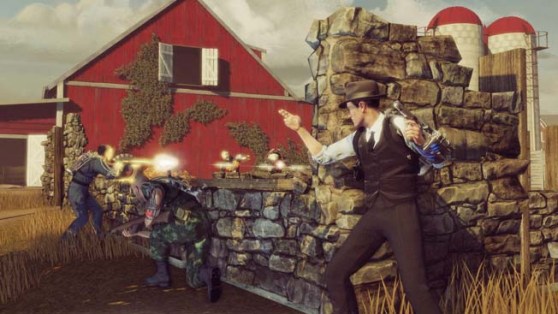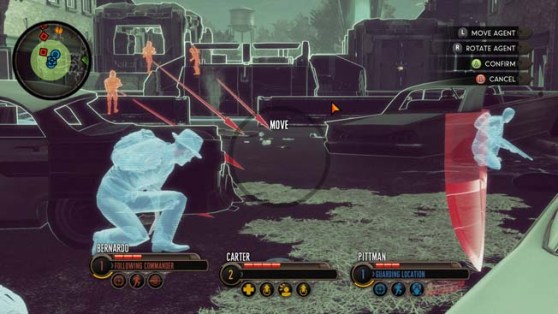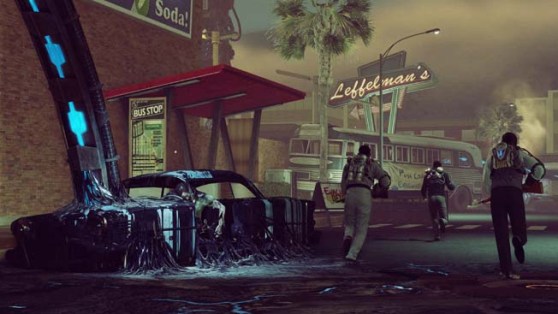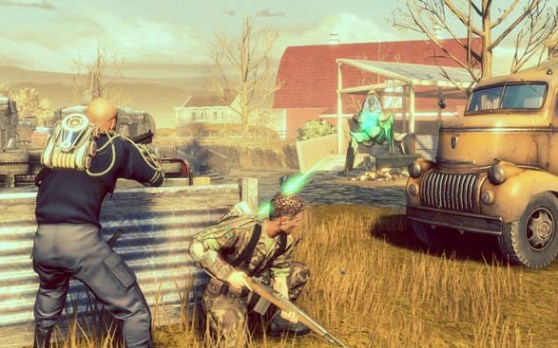I’ve been excited about The Bureau since before it existed. A few years ago, it was known by another name: XCOM. First revealed at E3 2010 as a first-person shooter that was “less Starship Troopers, more X-Files,” XCOM received a sour reaction at best. Diehard fans of the original X-COM games cried foul for bastardizing their beloved strategy series; gamers who were indifferent to the franchise cried foul for “yet another lazy FPS.”
I, on the other hand, saw potential.
Not content with the scraps shown off in canned presentations at media events, I basically bludgeoned my editor-in-chief into giving me a cover story for the magazine I worked at. A 10-page spread was enough to convince developer 2K Marin (BioShock 2) to open its doors and speak at length about its vision for a reimagined XCOM. It was obviously very early on, but my excitement remained. Then it missed its 2011 release window, and then its publicized release date the next year, finally falling off the radar altogether. Meanwhile, Firaxis Games’ XCOM: Enemy Unknown remake launched to universal acclaim.
Earlier this year, 2K Marin’s XCOM resurfaced as The Bureau: XCOM Declassified, now a prequel to Enemy Unknown (it hits the Xbox 360, PlayStation 3, and PC on Aug. 20). Again, I demanded to be on the front line of any behind-closed-doors coverage. What did 2K Marin change? Was this still the game I ranted and raved about to everyone after E3 a few years ago? Having now played several hours of a near-final version, the answer is very much yes — and very much no.
An origin story
XCOM: Enemy Unknown takes place in the near future, but 2K Marin’s creation was always intended to be set around the 1960s. That means the two can easily coexist with several decades of padding in-between (or at least, as easily as is possible between two separate studios creating games for a single canon). I noticed several alien units in The Bureau that are not in Enemy Unknown. Prequels with better technology or entire races that are inexplicably omitted further down the timeline are a common problem in entertainment (Star Wars, Halo, etc.), but the developer reassured me that all will be explained by the end of this game.
The Bureau focuses on the titular top-secret government organization that will eventually go on to be known as the globe-spanning Extraterrestrial Combat Unit (XCOM). Special Agent William Carter, the main character, spends just as much time talking to people at the base as he does on the ground fighting aliens. Unfortunately, for a game where characters spend so much time Ping-Ponging dialogue and exposition between each other, I wasn’t especially moved by any of the writing nor the presentation of the story.
Lead narrative designer Erik Caponi (The Matrix Online, Kingdoms of Amalur: Reckoning) joined the project just over a year ago after it was internally reborn as The Bureau. Caponi cites the movie The Right Stuff as one of the key inspirations for the story. “It’s all of these very serious men doing very serious things that were fucking crazy,” said Caponi. “It’s almost like mad science, from a modern perspective. They were really experimental, doing things that were not even remotely safe in a lot of cases.”
Although I didn’t reach it during my playtime, a large part of the story revolves around The Bureau building the Avenger, its very own flying saucer that will enable humanity to be a more formidable opponent to the Outsiders (aliens) as well as venture into seemingly nonhuman airspace/dimensions.
Rule No. 17: Don’t be a hero
Although Carter is the sole playable character, he can enter Battle Focus at any time to slow the flow of combat to a crawl and give orders to the two other agents in his squad. This is the core mechanic that 2K Marin has exhausted all its resources perfecting throughout The Bureau’s storied history.
As part of the day-long presentation, we got an exclusive look at the progression of Battle Focus. XCOM in 2010 didn’t even have a tactical element to it, while 2011’s E3 demo implemented the ability to give orders that use limited Time Units. 2K Marin experimented with various other user interface designs as well as, briefly, an Enemy Unknown-style overhead battle cam. But after years of development and playtesting, it definitely seems like the current Battle Focus is also the most succinct and rewarding.
Support units can accept commands such as Move (and then have the exact spot they need to move to, such as a piece of cover, carefully chosen), to focus fire on a single enemy, or to use an unlocked ability. Commands can be stacked, so you can tell your squadmate to move to one spot, throw up a turret, and then move to another spot that will put the enemy in a crossfire where the agent can now use a critical shot on them for the maximum level of efficiency.
Ignoring cover and/or Battle Focus will almost assuredly lead to your demise, so anyone hoping to Call of Duty the Outsiders back into whatever hole they crawled out of is going to have a frustrating time in The Bureau. Likewise, you must look after your agents as you would your own health, as they can be shot down and potentially killed — permanently. You can revive them during a bleedout phase, but if they go down away from cover, it can be impossible to save them without being downed yourself.
Agents and Carter himself can level up by gaining experience points. Each level grants a new passive or active ability (in some cases you’ll need to choose between two, permanently locking whichever option you didn’t go with). You can choose from five classes of agents, providing a substantial amount of flexibility to the kind of custom squad you want to build. Even some of the more unorthodox pairings (two support units, for example) may seem like a bad idea or unnecessary challenge early on, but later they could end up being a very powerful or enjoyable build.
2K Marin recommends leveling up multiple agents instead of just your two go-to guys in the off chance someone gets killed. To help with this process, optional Minor Operations are constantly available. “The goals of the minor operations, the side missions, are to give you really short, focused, quick narrative nuggets,” says lead developer Morgan Grey (BioShock 2, Tomb Raider: Legend). “They’re a great way for you to round out the agents in your roster. Put your primaries on the bench, take some secondary guys and get them up in levels so you have some support that you can cycle in if you lose someone major. I don’t want to call them ‘grindy,’ because you’re not just going out there farming rats in the noob zone. But they’re primarily built to give the player that option and to make them feel like, ‘Well, this isn’t a major operation, so I don’t need to always take my pros.’ It’s that place to get the rest of the roster up and field-tested and tried out before they commit to the next big phase of the campaign.”
In Enemy Unknown, the squad members aren’t especially fleshed out, other than their utility in combat. In a more linear, story-driven experience like The Bureau, I wondered if a different, deeper approach was being taken with the agents Carter can work with. “The agents, because they can die, are really difficult to work in the narrative,” says Caponi. “It would be impossible to do an infinite number of individual unique personalities and voices for all of them. So your relationship to them develops through gameplay. They become very valuable to you in terms of the experience you have with them in combat. They show up in cinematics and things, but they do not necessarily have distinct personalities of their own.”
And while Enemy Unknown had plenty of female squad members to choose from, The Bureau is strictly a boys club. “We thought about it, but ultimately we decided not to go that route, just because it didn’t necessarily feel right,” says Caponi. “In order to keep to the period, without using it as a crutch, it just didn’t necessarily seem like it was the right answer to fully unleash the Charlie’s Angels, essentially. Or that’s what it may have come across as.”
“We wanted misogyny to be an aspect,” adds Grey. “We wanted to have a character that was the focal point for that. Angela Weaver, her place in the hierarchy of the XCOM organization, we felt that was the perfect thing, and to have the contrast between the dudes in the field being where that tension comes from. ‘I’m not taking any orders from a dame.’ You get that from some of the agents. Some are more progressive. If we wanted to be period-appropriate, she was our viewpoint, and then with some of the other characters in the base, we could get that contrast. There’s also something unique about the period, looking at Mad Men, looking at The Right Stuff. 1962, it’s very much the older 30s, younger 40s white guys club. If you look at our characters, our characters don’t look like your classic video game characters. You’ve got a bunch of old dudes with glasses, which is cool. There were some, at the time—not tech, but just budgetary time things about building female models and animation sets and whatever. They came up as, ‘Can we afford to do this?’ ‘Probably, but it’s less relevant than what we’re trying to focus on.”
Why don’t more games take place in the ’60s?
The Battle Focus and combat is definitely The Bureau’s best gameplay feature, but the selling point, at least for me, is the incredibly realized vision of a 1962 Americana utterly ruined by an alien invasion. “I’m a huge fan of the period,” says lead art design Jeff Weir (BioShock 2, The Lord of the Rings: The Two Towers). “I grew up loving James Bond, the early James Bond pictures like Dr. No, Thunderball, and Goldfinger. I always thought that style was so iconic and so fresh and really kind of underused in media. I love the sort of futurism they had in the early ’60s, the very clean, crisp, spare look to everything. This idea that anything is possible.”
While the gameplay and story of what used to be known as XCOM has had numerous revisions, even apparently being thrown out altogether at several intervals, it seems like the art team has just had more and more time to refine the strong foundation first shown off in 2010. Like BioShock Infinite and The Darkness II, 2K has elected for a semi-cartoonish approach to the visuals that really brings the vibrant aesthetics to life without shaking the violent and ominous tone of the plot. In fact, seeing a small town’s homecoming parade decimated by an alien attack has a sort of hauntingly beautiful terribleness about it.
As for the Outsiders themselves, Weir has some less-obvious inspirations: “First and foremost, I was a huge fan of Dune. I thought the Harkonnens were really great villains that were kind of evocative of what’s going on nowadays, how we’re overly consuming our planet right now. There’s too many of us, and we’re still growing. We’re moving beyond our ability to sustain ourselves. These aliens are sort of an embodiment of that feeling, that they just don’t care. They’re going to consume and go on to the next thing and keep on eating.”
One of the more unique concepts that’s at least partially survived the transition from XCOM to The Bureau is xenophorming. The Outsiders launch giant glowing seeds below the ground that then begin overrunning sections of Earth and converting them into alien territory. Again, the contrast between the colorful decor of the era and the oppressive, black and slimy alien constructions is a visually stirring combination.
Streamlined and watered down
If you loved Enemy Unknown and are looking for The Bureau to essentially be a 1-to-1 copy of that experience but in third person, you’re going to be disappointed. Much of the Enemy Unknown’s gameplay took place off the battlefield, instead revolving around assimilating alien technology, research, engineering, aerial combat minigames, and building the XCOM base itself. All of that is gone in The Bureau.
Even the ability to capture alien technology and convert it into powerful weapons or upgrades, which was touted as a major part of the earlier iterations of the game, has been stripped out. Watch this video, where the developer uses the catchphrase “Every enemy is an opportunity.”
“Not a big deal for us,” says Grey. “We like that concept – take their technology, use it against them. We found that the game was getting a dissonance, a disconnect, between ‘Stay in cover, be smart, use your team, use flanks, be tactical’ and ‘Go out and grab shit!’ We’re telling you two things. Our user tests were telling us that that cognitive disconnect wasn’t doing us a service for people to understand the game that we were trying to make, and thus actually build the encounters, the mechanics, the setups that were being true to that.”
Unfortunately, 2K Marin did such a good job selling me on what an awesome and compelling component capturing alien technology was the first time around that it’s now got an uphill battle trying to tell me I’m better off without it.
Lastly, for those wondering about Ironman Mode, Enemy Unknown’s most unforgiving difficulty setting, Grey explains the team felt it wouldn’t quite resonate with The Bureau’s target audience. “Basically, our play on difficulty is primarily through the difficulty ratings and what they do in terms of permadeath, stabilize versus recover, the scaling back of agent autonomy and the quality of their individual A.I. versus requiring more from you to control them and coordinate them, and the upping of the enemies. The big reason, I’ll be frank—we discussed some harsh penalties, like no checkpoints, or checkpoint overwrites and things of that nature. But we realized that we’re actually living between multiple genres. We’re bridging a gap, hopefully, between fans of the classic turn-based XCOM that want to play from a new perspective, and people who don’t like turn-based and are already playing a lot of third-person shooters that frankly aren’t like our game in terms of what they demand or what they encourage and what they deny.
“We want to serve as that bridge. We figured we’re doing enough things that are new, unique, difficult, and challenging – people are going to say, ‘Oh, I have to control my squad’ – that we didn’t want it then to be that harsh for anyone, in terms of their ability. Even though Ironman mode would be elective, it was just like, ‘No, we’d have to balance towards that.’”
Although combat is difficult, and it has severe repercussions to making poor tactical decisions or trying to run-and-gun as a lone wolf, you can easily mulligan any botched encounter with a checkpoint restart. “Again, it’s the expectations of the genre,” says Grey. “It’s a shooter experience. It’s a directed narrative, linear experience. That’s the trope. I die, so I try this again. Because you have a lead character, there’s no going back to the mission and cycling out, because there’s only one Carter.”
Coming soon (finally)
Despite my issues with what I’ve seen so far, the combat gameplay that did make the cut is extremely enjoyable. I eventually started skipping cutscenes because I wanted to pick it up on release day and enjoy the whole thing uninterrupted. The story and cutscenes are hit-and-miss, and it has a plethora of secondary gameplay content absent not only from what you might expect after Enemy Unknown but also earlier versions of this game; still, people looking for a thrilling tactical shooter set in a masterfully crafted world should find much to enjoy in The Bureau.
VentureBeat's mission is to be a digital town square for technical decision-makers to gain knowledge about transformative enterprise technology and transact. Learn More





